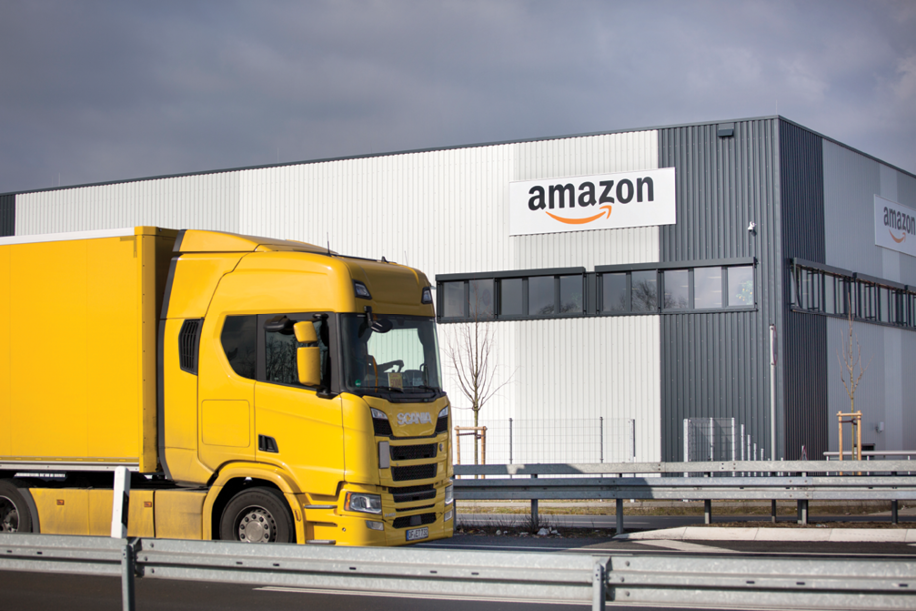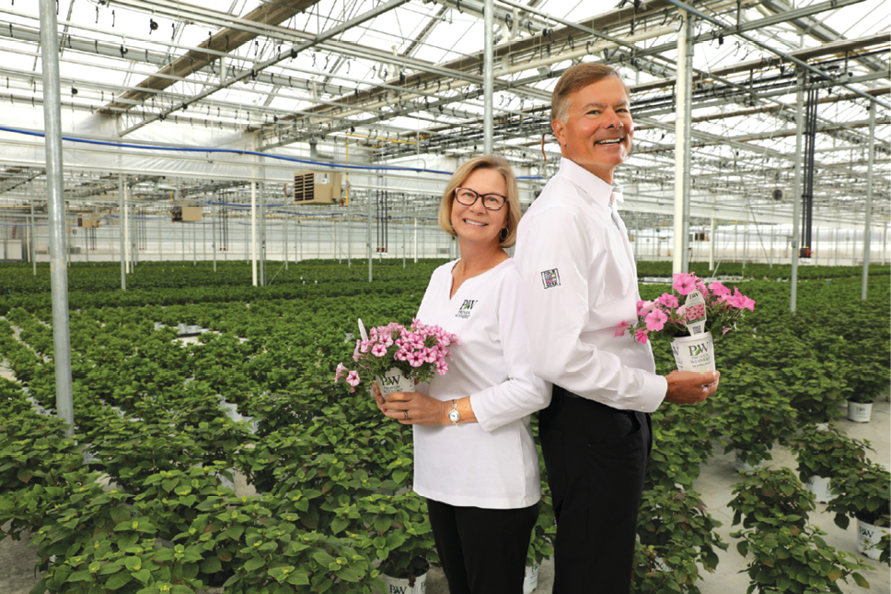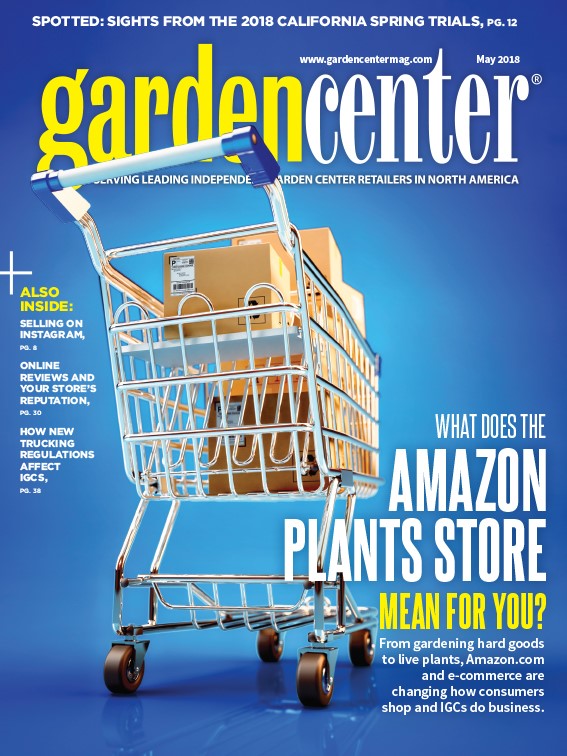

When Amazon representatives hit industry trade shows in 2016, rumblings about the e-commerce giant’s move into live plants swept the industry. Reactions ranged from warnings to welcomes. That ambivalence deepened with the recent launch of the Amazon Plants Store, adding a designated space for live plant sales to the company’s already extensive lawn and garden offerings.
Whatever your position on Amazon, understanding how this massive dotcom functions — and how online sales by manufacturers, growers, independent garden centers and other sellers fit in — can help you position your business for the new world ahead.
Putting Amazon in perspective
Amazon isn’t the only retailer affecting IGCs, but it’s hard to ignore its impact. In an annual shareholder letter released to media on April 18, Amazon.com CEO Jeff Bezos reported the company’s 2017 revenue hit $178 billion, a 31 percent increase from 2016. E-commerce analytics provider One Click Retail translates that figure to 4 percent of all U.S. retail sales and 44 percent of all U.S. e-commerce sales.

Bezos also confirmed that paid Amazon Prime memberships passed the 100-million mark in 2017. For an annual $99 fee, Prime members enjoy perks such as free two-day shipping — even on live plants — and exclusive sales. However, on April 26, Amazon announced it was increasing the annual Prime membership fee to $119, effective May 11.
Along with Amazon’s general sales, the company’s lawn and garden sales are growing, from lawn equipment and grills to pruners, fertilizers and live plants. In an early 2018 whitepaper on Amazon’s effect in the category, One Click Retail noted that lawn and garden sales by first-party, brand-manufacturers on Amazon topped $2 billion in 2017, with a year-over-year 25 percent increase in gardening products leading the charge.
Amazon sales and sellers simplified
For starters, understand that Amazon is not the only company selling on Amazon.com. In addition to “sold and shipped by Amazon” items, consumers shop from 2 million sellers that comprise the Amazon Marketplace, which includes many live plant and hard goods sellers. Amazon’s platform seamlessly integrates Marketplace offerings with their own, but listings advise attentive shoppers which parties offer and ship items being sold.
Amazon.com spells out basic Marketplace selling fees in “Make Money with Us” links at the bottom of its pages. Professional marketplace sellers list unlimited products for $39.99 per month, plus “referral fees” on sales.
Fees for Home & Garden products (including pet supplies) are 15 percent as of April 2018. Amazon handles all credit card payments, deducts referral fees and deposits the remainder directly into seller accounts every two weeks.
Some Amazon Marketplace sellers handle their own shipping, known as Fulfillment By Merchant (FBM). Others ship product to Amazon warehouses and let Amazon do the work, called Fulfillment By Amazon (FBA).
FBA sellers pay additional fees based on warehouse space and other factors, but their items qualify for Amazon Prime, a proven selling advantage with Amazon shoppers. Amazon’s Marketplace sales have grown as more businesses capitalize on the retailer’s reach and close-to-perfect logistics.
As noted in Bezos’s letter, more than 300,000 small and medium U.S.-based businesses became Marketplace sellers in 2017. In a first, Marketplace sales accounted for half of all items sold on Amazon.com for the year.
Amazon plants from a Proven Winners’ grower perspective
Marketplace sellers have offered live plants for more than a decade, but the launch of the Amazon Plants Store signals a new era. Live plants from bonsai, succulents and houseplants to annuals, perennials and shrubs are now being sold directly by Amazon as well.
According to an Amazon spokesperson, all live plants are sold through the Amazon Plants store, which can be as many as 100,000 live plants or seed items, depending on the season.
Four Star Greenhouse, the No. 1 supplier of Proven Winners, serves as an Amazon fulfillment center for “sold and shipped by Amazon” stock, which is separate from the Marketplace sales.
For Tom Smith, founding member of Proven Winners and Four Star’s president, brand integrity and plant quality were major considerations in the decision to sell to Amazon. “We wanted to do the best we could for the brand,” Smith says. “When Amazon came to us to be a fulfillment center, we knew either we do it or someone else would.”
As a fulfillment center, the grower negotiated pricing for shipped product, but that doesn’t equal an exclusive. “It makes us nervous,” Smith says. “If they ship a poor-quality plant from another source, that wouldn’t represent the brand well. Your reputation can be based off a poor grower that just puts plants online.”
Four Star has no control over retail pricing, but Smith believes Amazon plants won’t compete with box stores on price, even with Amazon’s efficiencies. “I’m not even sure if they’re making money at their current prices, which are higher than the average garden center now,” he says. “[The appeal of] online is convenience; it’s not pricing.”
All the Proven Winners line will be represented on Amazon, though items will list as “not in stock” at times. “They don’t commit to any numbers. It’s a wild card on Amazon, so it’s basically what we have available,” he says, adding that availability is a challenge.
“You have to get people out there counting plants, pot by pot, because that’s what you’re selling now — not cases — and you better be dead-on right,” Smith explains. “This isn’t something you can do once a week. It’s a daily process. If you don’t deliver or you deliver bad quality, you’re gone.”
Four Star plants ship in packaging designed in-house to ensure plants arrive in the optimal condition.

IGC perspectives on Amazon and online sales
With three retail garden centers, Pennsylvania-based Esbenshade’s Garden Centers began selling on their own website in 2005. “We were looking at opening new stores or creating a new revenue stream, and we decided to start offering the products we sell in our stores to customers online,” says second-generation owner Terry Esbenshade.
The grower-retailer’s online business expanded to the Amazon.com Marketplace in 2013. They also sell on Walmart.com, eBay.com and Jet.com. Pricing strategies vary by selling platform. “Once you get into the marketplaces, the rules totally change,” Esbenshade says. “Typical retail profit margins go out the window.” Factors, fees and competition in each marketplace demand unique strategies and tools to track true margins and sell profitably.
Local customers use Esbenshades.com as a shopping tool, so prices there stay equal to in-store plus shipping. In support of local stores and customers, the website’s shoppers can view store-by-store inventory, buy online, order delivery or pick up in-store. These costly features aren’t readily available in out-of-the-box e-commerce shopping solutions, but Esbenshade finds that local customers increasingly pre-shop online.
Hard goods constitute most of Esbenshade’s online sales, though plants are a focus. One challenge is compliance with plant regulations in all 48 contiguous states — something Esbenshade feels many online sellers ignore. “We’re playing by the rules, and we’re up against competition that, at this point, is doing whatever they want,” he says. A search on Amazon supports those concerns.
Like Smith, Esbenshade emphasizes the stringent requirements tied to Amazon selling privileges, but business has been robust. The IGC plans to expand on Amazon and other online sales channels, including a new dotcom of their own by year end. “The goal is to continue growing our online presence through an omnichannel perspective. We don’t want all of our eggs to be in one basket,” Esbenshade says.
Online retailer Garden Crossings in Zeeland, Mich., started as an online mail-order business in 2002, focused on new and unusual plants not readily available in local garden centers.
Their brick-and-mortar retail garden center came later. In addition to its own thriving online business, Garden Crossings fulfills orders for several leading plant brands and independent retailers that operate online storefronts. They do not do business on Amazon.com or any other online marketplace.
Several factors influenced that decision, but concerns about quality and customer success keep the retailer focused on their current business. “One primary reason we don’t do business on Amazon is that you can’t take orders in winter for spring shipment,” says owner Heidi Grasman. “I’m not going to ship when it’s inappropriate for a zone. Amazon is ship-on-demand.
“Our main goal is we want the customer to have success in what they’re growing. If they don’t, it’s ultimately a reflection on us,” Grasman continues. “Quality and customer success are our No. 1 things, so we prefer to do it solely through our website and not to do business on Amazon at this time.”

Selling restrictions and independent-only promises
As online sales grow, concerns about brand integrity and exclusivity build among brand manufacturers and IGCs. “Brand manufacturers don’t know how to navigate it, and they’re extremely concerned with protecting brand integrity,” Esbenshade says. Many vendors now prohibit marketplace sales of their products. Policies change frequently, with little notice, sometimes leaving online retailers with product they can no longer sell online.
As a local store and online seller, Esbenshade is concerned about manufacturers that offer independent-only brands, which then end up sold directly by Amazon. “If we’re selling it, it’s always going to be cheaper in-store. But if Amazon is selling it, that’s different,” he says. “We kind of like Amazon, and we kind of feel like we don’t like Amazon. It’s a really weird relationship.
“The manufacturer can keep it out of Home Depot or Lowe’s, but what are they going to do about Amazon.com? I’m talking about products Amazon is able to obtain and directly sell themselves — not third-party sellers,” Esbenshade continues. “My question is, how is Amazon.com as a seller any different than Lowe’s and Home Depot? I think there’s going to be more manufacturers policing that, but it’s only going to happen when IGCs put pressure on them to do so.”

So what does it mean for your IGC?
As Amazon advances in live plants and other categories, views about online sales as threats or opportunities for brick-and-mortar IGCs continue to differ. Smith hopes that Amazon listings with extensive, accurate plant information — covering hardiness, dormancy, container size, seasonal appearance and life cycle — serve as both shopping tools that generate local garden center sales and educational tools that reach non-gardeners where they shop.
“I’m optimistic,” Smith says. “I don’t see this as displacing independent garden centers at all. I see this as an opportunity to continue to grow with garden centers and build [a larger] consumer base. I’m hoping this is the kind of gateway that helps people become gardeners, especially Millennials and people always on their phone, and brings them into gardening and garden centers.”
Esbenshade tempers optimism with down-to-earth advice: “I believe the notion that Amazon will put IGCs out of business is false, although I think there’s some warning that should be heeded.” He says that product mix in stores will change as IGC customers turn to online sales for some categories. Online plants will grow and be a force to reckon with, but he believes avid gardeners won’t bypass IGCs.
“When you look at the core of IGCs in our spring season, there’s an element that Amazon is not going to be able to pick up,” he says. “Will it put pressure on us in other product categories? Absolutely. Is it for every IGC to get into? No.”
With 13 years of online experience, Esbenshade stresses that selling online is a totally different business than a retail store — one that takes significant time and capital to develop. “If you decide to go into online business, it doesn’t change what you have to do to keep your store relevant,” he says. “They’re two different businesses.”
Esbenshade offers this final tip: “If what you do well is run your garden center, you should probably really focus on that and the aspects that are going to keep you relevant in this changing marketplace. I would recommend IGC owners and operators figure out what you’re really good at — and stick with it.”

Explore the May 2018 Issue
Check out more from this issue and find your next story to read.
Latest from Garden Center
- GS1 US Celebrates 50-Year Barcode 'Scanniversary' and Heralds Next-Generation Barcode to Support Modern Commerce
- Weekend Reading 7/26/24
- Retail Revival: Making gardening contagious
- ‘Part of our story’
- Registration now open for Garden Center Fertile Ground Webinar Series
- Dramm introduces new hose, sprinkler attachments for home gardeners, nurseries
- Meet the 15 Retailers' Choice Awards winners from Cultivate'24
- 2024 Top 100 Independent Garden Centers List





